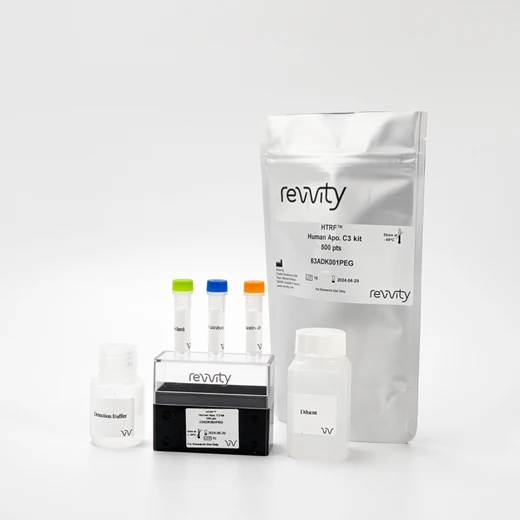

HTRF Human ApoC3 Detection Kit, 500 Assay Points


 View All
View All
HTRF Human ApoC3 Detection Kit, 500 Assay Points










The ApoC3 kit is designed for the simple quantification of ApoC3 in cell-based formats.
For research use only. Not for use in diagnostic procedures. All products to be used in accordance with applicable laws and regulations including without limitation, consumption and disposal requirements under European REACH regulations (EC 1907/2006).
| Feature | Specification |
|---|---|
| Application | Protein Quantification |
| Sample Volume | 16 µL |
The ApoC3 kit is designed for the simple quantification of ApoC3 in cell-based formats.
For research use only. Not for use in diagnostic procedures. All products to be used in accordance with applicable laws and regulations including without limitation, consumption and disposal requirements under European REACH regulations (EC 1907/2006).





HTRF Human ApoC3 Detection Kit, 500 Assay Points





HTRF Human ApoC3 Detection Kit, 500 Assay Points





Product information
Overview
Apolipoproteins are proteins that bind to lipids to form lipoproteins, whose main function is to transport lipids. Apolipoproteins are important in maintaining the structural integrity and solubility of lipoproteins, and play an important role in lipoprotein receptor recognition and regulation of certain enzymes in lipoprotein metabolism. ApoC3 inhibits lipoprotein lipase and hepatic lipase. Increased ApoC3 expression may lead to hypertriglyceridaemia and an atherogenic lipoprotein profile.
Specifications
| Application |
Protein Quantification
|
|---|---|
| Brand |
HTRF
|
| Detection Modality |
HTRF
|
| Product Group |
Kit
|
| Sample Volume |
16 µL
|
| Shipping Conditions |
Shipped in Dry Ice
|
| Target Class |
Biomarkers
|
| Target Species |
Human
|
| Technology |
TR-FRET
|
| Therapeutic Area |
Cardiovascular
Metabolism/Diabetes
NASH/Fibrosis
Neuroscience
|
| Unit Size |
500 Assay Points
|
Video gallery

HTRF Human ApoC3 Detection Kit, 500 Assay Points

HTRF Human ApoC3 Detection Kit, 500 Assay Points

How it works
Assay principle
The Apolipoprotein C3 assay is a sandwich immunoassay involving two monoclonal antibodies, one labelled with Eu-Cryptate (Donor) and the second with d2 (Acceptor). The intensity of the signal is proportional to the concentration of apolipoprotein present in the sample.

Assay protocol
The ApoC3 assay features a streamlined protocol with only one incubation step following the sample/calibrator and Antibody conjugates dispensing. The antibodies labelled with HTRF donor and acceptor may be pre-mixed and added in a single dispensing step to further streamline the assay procedure. This protocol requires a single 2-hour incubation period at RT.

Assay details
| Human Apo CIII | |
|---|---|
| Incubation | 2h at RT (or ON) |
| Assay range | 0.321 to 125 ng/mL |
| Detection limit | 0.112 ng/mL |
Analytical performance
Intra/Inter assay
Intra-assay (n=22)
| Sample | Mean [ApoC3] (ng/mL) | CV |
|---|---|---|
| 1 | 1.15 | 13.2 |
| 2 | 11.8 | 9 |
| 3 | 121.8 | 9.5 |
| Mean CV | 10.5 |
Each of the 3 samples was measured 22 times, and the %CV for the concentration was calculated for each sample.
Inter-assay (n=4)
| Sample | [ApoC3] (ng/mL) | Mean (delta R) | CV |
|---|---|---|---|
| 1 | 9.79 | 2986 | 8 |
| 2 | 50.6 | 12644 | 11 |
| 3 | 105 | 21141 | 7 |
| Mean CV | 8.6 |
Each of the samples was measured in 4 different experiments, and the %CV for the concentration was calculated for each sample.
Resources
Are you looking for resources, click on the resource type to explore further.
Discover the versatility and precision of Homogeneous Time-Resolved Fluorescence (HTRF) technology. Our HTRF portfolio offers a...


How can we help you?
We are here to answer your questions.






























